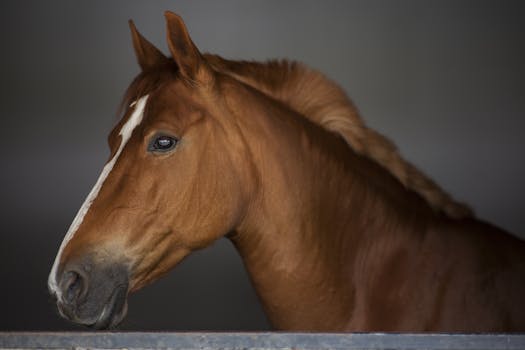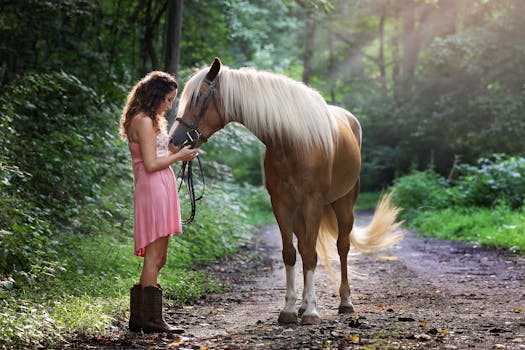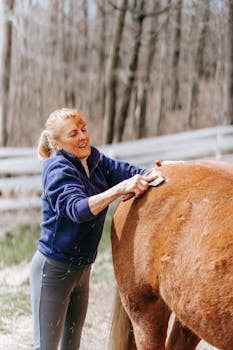Bonding Beyond the Saddle
Strategies for Deepening Your Relationship with Your Horse

Understanding Equine Behavior: Foundations of a Strong Bond
To develop a strong bond with your horse, it's crucial to delve into the realm of equine behavior. Horses are highly social and sensitive animals, with complex communication methods that go beyond verbal cues. By understanding their behavior and natural instincts, you can lay a solid foundation for a deep and meaningful relationship with your equine companion.
Communication is Key
One of the fundamental aspects of understanding equine behavior is communication. Horses communicate through body language, vocalizations, and subtle cues. Learning to read and respond to these signals is essential for building trust and mutual understanding.
Body Language: Horses are incredibly expressive through their body language. They use ear position, tail movement, posture, and facial expressions to convey their emotions and intentions. For example, pinned ears may indicate discomfort or aggression, while relaxed ears and a soft gaze signal contentment.
Vocalizations: While horses are not as vocal as some other animals, they still use sounds like neighs, whinnies, snorts, and nickers to communicate. These vocalizations can convey emotions such as excitement, fear, or frustration. Paying attention to the nuances of these sounds can help you better understand your horse's state of mind.
Subtle Cues: Horses are sensitive to even the slightest cues from their environment and handlers. Your body position, movements, and energy levels can all influence how your horse responds to you. Being aware of these subtle cues and maintaining a calm and confident demeanor can foster a sense of security and trust in your horse.
Understanding Natural Instincts
Equine behavior is also shaped by their natural instincts, which have evolved over centuries of living in herds and navigating their environment. By understanding these instincts, you can work with your horse's nature rather than against it.
Herd Mentality: Horses are herd animals, and their natural instinct is to seek safety and companionship within a group. When interacting with your horse, keep in mind their social nature and the importance of companionship. Spending time together, grooming, and engaging in activities that mimic herd dynamics can strengthen your bond.
Flight Response: Horses have a strong flight response, meaning they are quick to react to perceived threats by fleeing. This instinct is rooted in their survival mechanisms. Understanding this innate response can help you approach training and handling with patience and empathy, avoiding situations that trigger fear or stress.
Hierarchy and Leadership: In a herd setting, horses establish a hierarchy based on leadership and dominance. As the handler, it's essential to establish yourself as a calm and confident leader without resorting to aggression. Clear and consistent communication, along with positive reinforcement, can help reinforce your role as a trusted leader in your horse's eyes.
Building Trust Through Consistency and Respect
Consistency and respect are pillars of building a strong bond with your horse. Consistent training methods, routines, and interactions create predictability and security for your horse, leading to trust and confidence in your partnership.
Consistent Training: Training your horse with clear and consistent cues helps them understand what is expected of them. Whether it's groundwork exercises, riding techniques, or handling procedures, consistency in your approach fosters trust and reliability in your horse's responses.
Respectful Handling: Respectful handling involves treating your horse with kindness, patience, and understanding. Avoiding harsh methods or punishment builds trust and encourages a willing partnership. Respect also means listening to your horse's cues and adjusting your approach to meet their needs.
Creating a Safe Environment: Providing a safe and comfortable environment for your horse is crucial for building trust. This includes proper housing, nutrition, healthcare, and social interaction. A secure and nurturing environment allows your horse to relax, bond, and thrive in your care.
In conclusion, understanding equine behavior is essential for developing a strong bond with your horse. By communicating effectively, respecting their instincts, and building trust through consistency and respect, you can create a meaningful partnership based on mutual understanding and companionship.
Communication Beyond Words: Developing a Language of Trust The groundwork for Trust: Building Confidence and Respect

Communication Beyond Words: Developing a Language of Trust
Effective communication forms the cornerstone of a strong bond between you and your horse. While words may not be part of the equation, the language of trust is spoken through actions, body language, and mutual understanding. In this chapter, we'll explore how to develop a communication style that fosters trust, builds confidence, and cultivates respect in your relationship with your horse.
The Groundwork for Trust: Building Confidence and Respect
Groundwork refers to the foundational exercises and interactions you have with your horse while on the ground. These activities not only establish boundaries and rules but also lay the groundwork for trust, respect, and communication.
Leading with Purpose: When leading your horse, do so with intention and purpose. Use clear cues and body language to indicate direction and pace. Avoid pulling or tugging on the lead rope; instead, use gentle pressure and release techniques to communicate your expectations. Consistent and confident leading helps your horse feel secure and trust your guidance.
Desensitization Exercises: Introduce your horse to various stimuli in a controlled and gradual manner. This could include introducing them to different objects, sounds, and environments. Start with less challenging stimuli and gradually increase the difficulty as your horse becomes more confident. Desensitization exercises build trust by showing your horse that unfamiliar or potentially scary situations are nothing to fear.
Obstacle Courses: Set up obstacle courses that require your horse to navigate through different challenges such as poles, cones, tarps, and bridges. These courses not only improve your horse's physical coordination but also enhance their mental focus and trust in your guidance. Start with simple obstacles and progress to more complex ones as your horse gains confidence.
Groundwork Games: Engage in playful groundwork games that encourage communication and cooperation. Games like "follow the leader," "backing up," and "side passing" not only make training fun but also strengthen the bond between you and your horse. Use positive reinforcement, such as treats or praise, to reward desired behaviors and motivate your horse to participate willingly.
Round Pen Work: Utilize a round pen for liberty training and communication exercises. Allow your horse to move freely while using body language, voice cues, and gestures to communicate with them. The round pen provides a safe and enclosed space for building trust, establishing boundaries, and refining your communication skills without the need for physical restraint.
Body Language Awareness: Pay close attention to your horse's body language and respond accordingly. Learn to interpret signs of relaxation, tension, curiosity, and discomfort. Adjust your own body language to convey calmness, confidence, and leadership. Consistent and clear body language enhances communication and deepens the bond between you and your horse.
Respectful Handling: Handle your horse with respect and empathy. Avoid harsh corrections or punishments and instead focus on positive reinforcement and reward-based training. Respectful handling builds trust and encourages your horse to willingly engage with you in training and activities.
By incorporating these groundwork exercises into your routine, you lay the foundation for a strong and trusting relationship with your horse. Effective communication, clear boundaries, mutual respect, and positive reinforcement create an environment where trust flourishes, and your bond deepens beyond words.
The Power of Patience: Cultivating a Deeper Connection Over Time
Patience is not just a virtue; it's a powerful tool in developing a strong bond with your horse. Building a deep connection takes time, consistency, and a willingness to understand and respect your horse's pace. In this chapter, we'll explore the importance of patience in strengthening your relationship with your equine partner and share strategies for cultivating a deeper connection over time.
Understanding the Nature of Patience
Patience in horsemanship goes beyond simply waiting for results; it involves a deep understanding of your horse's needs, behaviors, and learning process. Horses are sensitive animals that respond best to patient, calm, and consistent handling. Rushing or pushing them beyond their comfort zone can lead to stress, fear, and a breakdown in trust.
Developing Patience as a Skill
Patience is a skill that can be cultivated and honed over time. Here are some strategies to develop and practice patience in your interactions with your horse:
Mindfulness and Presence: Practice being fully present and mindful during your interactions with your horse. Focus on observing their body language, responses, and cues without rushing or anticipating outcomes. Being present in the moment allows you to respond appropriately and adjust your approach based on your horse's feedback.
Setting Realistic Expectations: Understand that building a strong bond takes time and consistency. Set realistic goals and expectations for yourself and your horse, taking into account their individual personality, background, and training level. Celebrate small victories and progress along the way, rather than focusing solely on the end result.
Consistent Training and Routine: Establish a consistent training routine that includes regular sessions focused on bonding and communication. Consistency helps your horse feel secure and confident, leading to trust and a deeper connection over time. Avoid sudden changes or disruptions in your training schedule that can cause confusion or stress.
Practice Patience in Training: When working on new skills or behaviors, break them down into small, manageable steps. Progress at a pace that allows your horse to understand and succeed without feeling overwhelmed. Use positive reinforcement, praise, and rewards to encourage desired behaviors and motivate your horse to learn and engage with enthusiasm.
Embrace Mistakes as Learning Opportunities: Understand that mistakes are a natural part of the learning process for both you and your horse. Instead of becoming frustrated or impatient, view mistakes as valuable learning opportunities. Take the time to analyze what went wrong, adjust your approach if necessary, and try again with patience and persistence.
Listen to Your Horse: Pay attention to your horse's feedback and adjust your training and interactions accordingly. If your horse is showing signs of stress, resistance, or confusion, take a step back and reassess your approach. Listen to their cues and communicate with empathy, understanding, and patience.

The Benefits of Patience in Bonding
Practicing patience in your relationship with your horse yields numerous benefits that contribute to a strong and lasting bond:
Trust and Confidence: Patience builds trust as your horse learns to rely on your consistent, calm, and respectful approach. Trust leads to confidence in their interactions with you and a willingness to try new things and overcome challenges together.
Mutual Understanding: Patience allows you to develop a deeper understanding of your horse's personality, preferences, and communication style. This mutual understanding fosters a stronger connection based on empathy, respect, and effective communication.
Resilience and Perseverance: Patience teaches resilience and perseverance, both essential qualities in horsemanship. Building a bond with your horse requires dedication, perseverance through setbacks, and a belief in the power of patience to overcome challenges.
Emotional Connection: Patience nurtures an emotional connection between you and your horse, creating a bond that goes beyond physical interactions. This emotional connection is based on trust, empathy, and a shared journey of learning and growth.
In conclusion, patience is a powerful tool in developing a strong bond with your horse. By cultivating patience as a skill, setting realistic expectations, practicing consistent training and routine, embracing mistakes as learning opportunities, listening to your horse, and recognizing the benefits of patience in bonding, you create an environment of trust, understanding, and mutual respect. Patience allows you to cultivate a deeper connection over time, leading to a fulfilling and harmonious relationship with your equine partner.
Bonding Through Grooming: A Ritual of Care and Affection
Grooming is much more than a routine task; it's a powerful ritual of care, affection, and connection between you and your horse. In this chapter, we'll explore how grooming plays a significant role in deepening your relationship with your equine partner and share insights on making this activity a meaningful bonding experience.
The Importance of Grooming in Horse Bonding
Grooming serves multiple purposes beyond keeping your horse clean and tidy. It is a vital aspect of horse care that promotes physical health, emotional well-being, and strengthens the bond between horse and rider. Here are some key reasons why grooming is crucial for bonding:
Physical Health: Regular grooming helps maintain your horse's skin, coat, and overall health. Removing dirt, debris, and loose hair prevents skin irritation, promotes circulation, and allows you to inspect for any signs of injuries or health issues. A well-groomed horse is not only healthier but also more comfortable and happy.
Emotional Well-being: Grooming provides a soothing and relaxing experience for your horse. The repetitive motion of brushing and grooming releases endorphins, reducing stress and anxiety. It also allows for tactile interaction and touch, which are essential for emotional bonding and trust-building.
Bonding and Trust: Grooming creates a bond of trust and affection between you and your horse. Spending time grooming your horse fosters a sense of closeness and intimacy as you engage in a nurturing and caring activity together. Your horse learns to associate grooming with positive experiences and develops trust in your care and attention.
Communication and Body Language: Grooming allows you to communicate nonverbally with your horse through touch, body language, and gentle cues. Paying attention to your horse's reactions during grooming helps you understand their preferences, sensitivities, and mood. It strengthens your ability to communicate effectively and empathetically with your equine partner.
Making Grooming a Meaningful Bonding Experience
To enhance the bonding experience through grooming, consider the following tips and strategies:
Create a Calm Environment: Choose a quiet and peaceful location for grooming to minimize distractions and create a relaxing atmosphere. Play soothing music or use calming scents like lavender to further promote a sense of tranquility.
Use Quality Grooming Tools: Invest in high-quality grooming tools such as brushes, combs, hoof picks, and grooming sprays. Choose tools that are suitable for your horse's coat type and sensitive areas. Using gentle and appropriate grooming techniques ensures a comfortable and enjoyable experience for your horse.
Start with a Routine: Establish a grooming routine that includes brushing, mane and tail care, hoof cleaning, and inspection of ears, eyes, and skin. Consistency in your grooming routine helps your horse feel secure and familiar with the process, reducing anxiety and stress.
Be Attentive and Gentle: Pay attention to your horse's body language and reactions during grooming. Be gentle and patient, especially when handling sensitive areas or grooming areas that your horse may be uncomfortable with. Use soft, soothing strokes and avoid rough or abrupt movements.
Use Grooming as a Bonding Time: View grooming as a bonding activity rather than just a task. Take the time to talk to your horse, offer praise and encouragement, and show affection through gentle touches and pats. Use grooming sessions to connect with your horse on an emotional level and strengthen your bond.
Incorporate Massage and Stretching: Consider incorporating massage and stretching techniques into your grooming routine. Gentle massage strokes and stretching exercises promote relaxation, improve circulation, and enhance flexibility. These additional activities deepen the physical and emotional benefits of grooming.
Monitor Your Horse's Health: Use grooming as an opportunity to monitor your horse's overall health and well-being. Check for any changes in their coat, skin, hooves, or body condition. Address any concerns or abnormalities promptly to ensure your horse remains healthy and comfortable.
The Ritual of Care and Affection
Grooming is more than just brushing and cleaning; it's a ritual of care, affection, and connection that strengthens the bond between you and your horse. By approaching grooming with mindfulness, patience, and a focus on building trust and intimacy, you create a meaningful bonding experience that enhances the overall well-being and happiness of your equine partner. Embrace grooming as a cherished ritual in your relationship with your horse, and watch as your bond grows deeper and stronger over time.
No comments:
Post a Comment